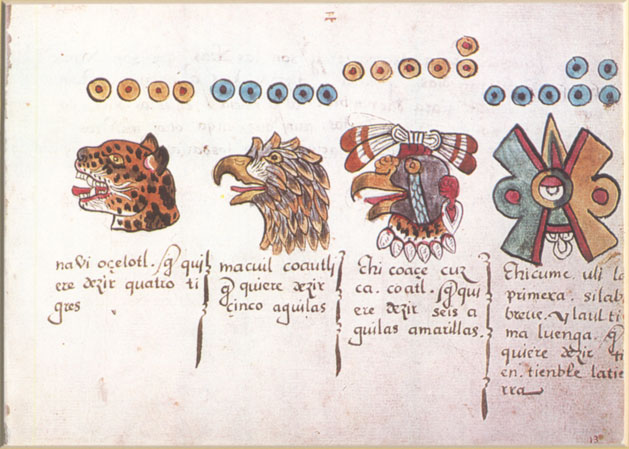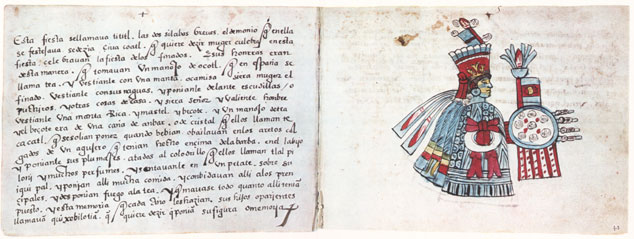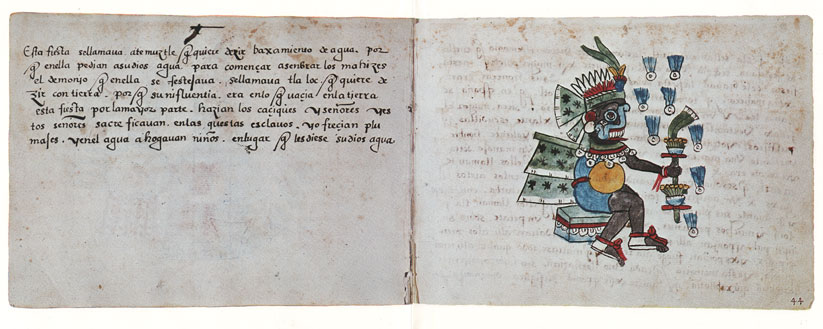The Magliabechi Codex was probably sent to Europe in the mid-16th century,
where it came to be in the collection of Antonio Magliabechi. After his death
it was acquired by the Biblioteca Nazionale Centrale in Florence, Italy, where
it is today. The Magliabechi is generally accepted to be a copy of an earlier
Aztec codex and was likely created in 1553 in Tenochtitlán. This codex lends its
name to the Magliabechiano Group of códices, which were produced after the conquest
and are copies of pre-conquest códices. This group includes the Codex Tudela,
Codex Ixtlilxóchitl, and Codex Veytia.
The Magliabechi has 92 pages, is made from European paper, and has drawings
and text on both sides of each page. It is comprised of six sections:
Pages 11r-13r represent the Tonalophualli calendar through the count of 20
days, with four day-glyphs on each page. Above each glyph are circle notations
indicating the number of that day, and the text below gives the day-name in Nahuatl,
followed by a translation or description in Spanish. Items 16a to 16e depict a
veintena beginning with 1-Flint and ending with 7-Movement. The calendar and day-glyphs
were used as auguries in the people's daily lives; for example, the text on page
12r states that it is a bad omen to be born on the day 9-Death.
 |
- Magliabechi, page 11r
Aztec date: 1-Flint-Knife
ce tecpatl, que es una piedra de pedernal a figura de hierro con que ellos
sacrificaban.
... which is one flint stone as a figure of a blade with which they performed
sacrifice.
Aztec date: 2-Rain
ome quiauitl, que quiere decir dos llovecinas o aguaceros.
... which means two drizzles or down-pours.
Aztec date: 3-Flower
yei suchitl, que quiere decir tres Rosas.
... which means three flowers.
Aztec date: 4-Crocodile
nau[i] cipactl[i], que es una cosa viva que anda en el agua como serpelliza.
... which is a living thing that goes around in the water like a little snake.
|
 |
- Magliabechi, page 11v
Aztec date: 5-Wind
macuili e[h]ecatl, qu[e] es cinco vientos.
... which is five winds.
Aztec date: 6-House
chicoaçe cale, que quiere decir seis casas.
... which means six houses.
Aztec date: 7-Lizard
chicume cuezpali[n], que quiere decir siete lagartijas.
... which means seven lizards.
Aztec date: 8-Snake
chicuei coatl, que quiere decir ocho culebras.
... which means eight serpents.
|
 |
- Magliabechi, page 12r
Aztec date: 9-Death
chicunaui miquiztli, que quiere decir nueve muertos. El que nace este día dicen
que es señal entre ellos que ha de morir luego, y ofrecen sacrificio al demonio
por que le dé vida.
... which means nine deaths. He who is born on this day, they say it is a sign
among them that he is bound to die shortly, and they offer a sacrifice to the
demon for his life.
Aztec date: 10-Deer
matlacl[i] mazatl, que quiere decir diez ciervos o bestias.
... which means ten deer or beasts.
Aztec date: 11-Rabbit
matla[c]li u[n]ce tochtli, que quiere decir once conejos.
... which means eleven rabbits.
Aztec date: 12-Water
matla[c]tli ome atl, que quiere decir doce aguas.
... which means twelve waters.
|
 |
- Magliabechi, page 12v
Aztec date: 13-Dog
matlactli uney itzcuintli, que quiere decir trece perrillos.
... which means thirteen little dogs.
Aztec date: 1-Monkey
ce uçumatli, que quiere decir una mona.
... which means one monkey.
Aztec date: 2-Grass
ume malinalli, que quiere decir dos hierbas de este nombre porque torcer quiere
decir malinale.
... which means two grasses of this name because twisting means "malinale."
Aztec date: 3-Reed
yei acatl quiere decir tres cañas.
... which means three reeds.
|
 |
- Magliabechi, page 13r
Aztec date: 4-Jaguar
naui oçelotl, que quiere decir cuatro tigres.
... which means four tigers.
Aztec date: 5-Eagle
macuil cuau[h]tl[i], que quiere decir cinco águilas.
... which means five eagles.
Aztec date: 6-Vulture
chicoaçe cuzcacoa[uh]tl[i], que quiere decir seis águilas amarillas.
... which means six yellow eagles.
Aztec date: 7-Movement
chicume uli[n] -la primera sílaba breve y la última luenga-, que quiere decir
tiemble la tierra.
... the first syllable short and the last one long-, which means the earth shakes.
|
 |
- Magliabechi, pages 42v and 43r
Pages 42v-44r represent feasts or celebrations held throughout the solar year
for each of the 18 veintenas or "months." Page 42v describes the celebration
of Panquetzaliztli, the greatest feast of the year, which was celebrated
from ca. November 19th to December 8th. The feast name comes from pantli
(banner) and Huitzilopochtli (the god of war), and the central figure is
of the god wearing a wide blue banner. Many prisoners of war were sacrificed during
this feast each year.
Page 43r depicts Huitzilopochtli wearing a blue hummingbird as an ear
ornament. Huitzilopochtli means "hummingbird from the left" in Nahuatl,
and this imagery is associated with warriors killed in battle whose spirits were
believed to return from the South, reincarnated as hummingbirds. It was at Huitzilopochtli's
command that the city of Tenochtitlán was founded on the island in Lake Texcoco. |
 |
- Magliabechi, page 43v and 44r
These two pages describe the celebration for the 16th veintena, called
Atemoztli, which was celebrated from December 9th to December 28th. The
name Atemoztli means "falling of water" in Nahuatl; during this feast the
Aztecs asked their god for water in order to begin sowing the season's corn. The
commentator writes that the "demon" who was honored was named Tlaloc (the
god of water), that this feast was attended principally by the chiefs and lords,
and that the related rituals included sacrificing slaves in the hills, drowning
children so that their god might give them water, and making offerings of feathers.
Page 44r shows Tlaloc with the typical blue ring around his eye, a blue
jaw, and large teeth. |



